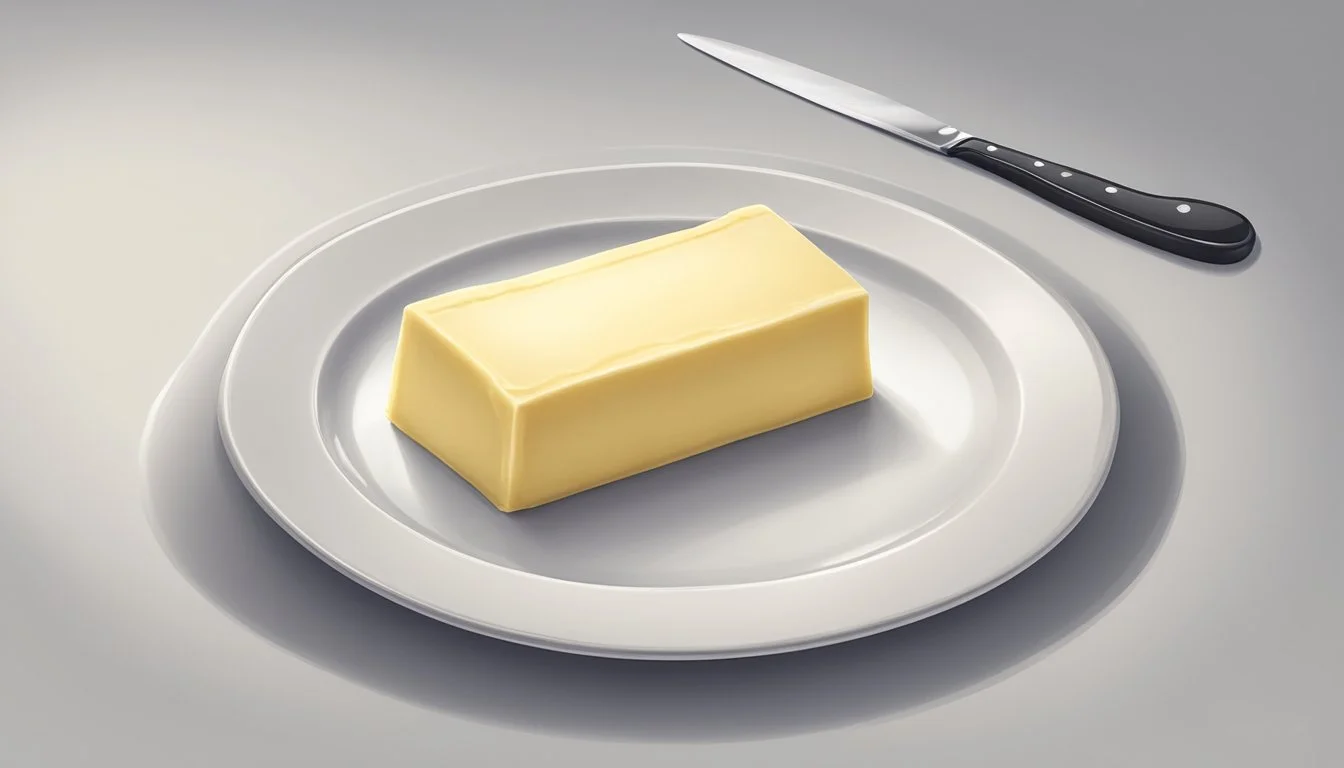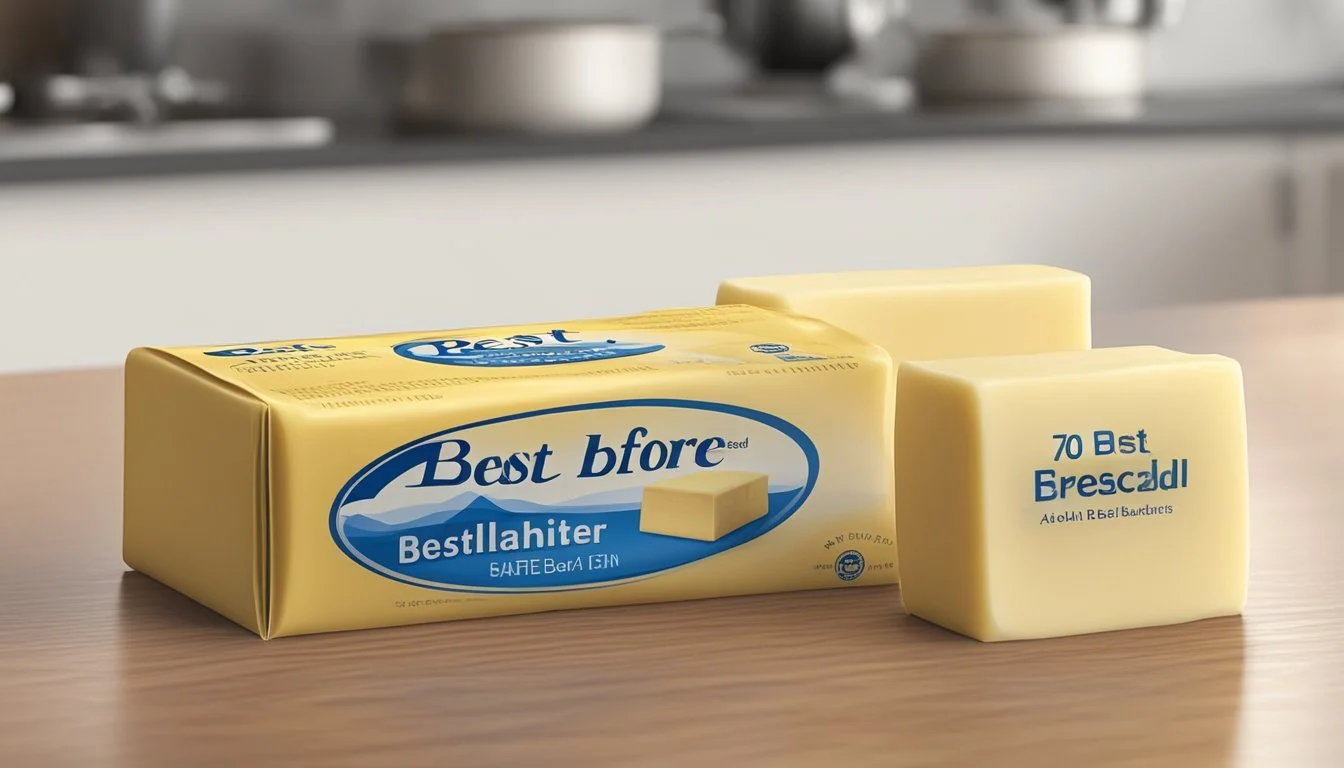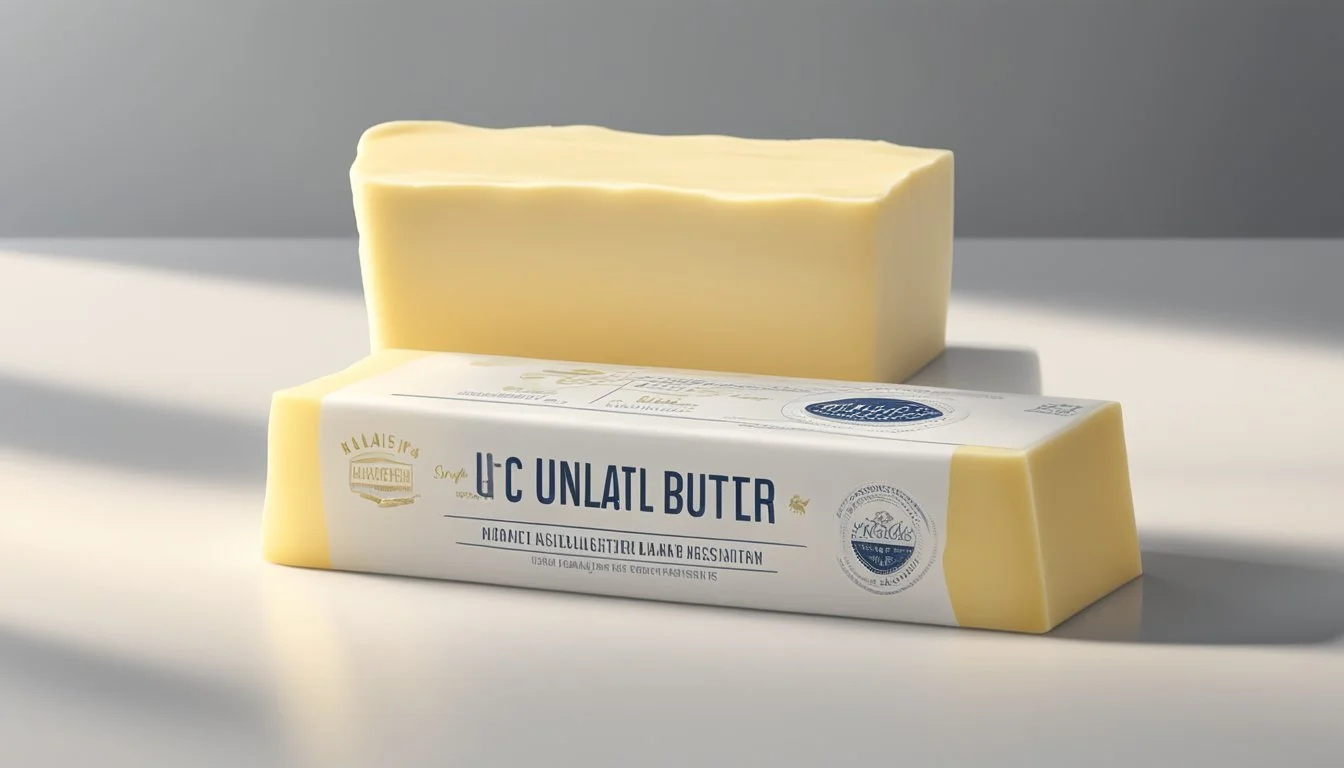How Long Does Unsalted Butter Last?
Shelf Life and Storage Tips
Unsalted butter (how long does butter last?) is a staple in many kitchens, valued both for its versatility in cooking and its pure, sweet flavor for finishing dishes. Unlike its salted counterpart which benefits from the preservative effects of salt, unsalted butter has a shorter shelf life. The absence of salt means it is more prone to spoilage due to the growth of bacteria and other microorganisms. The typical guideline for the refrigerated shelf life of unsalted butter is about three to five months which ensures that it retains its quality and taste.
When stored in the refrigerator, unsalted butter should be kept in its original packaging or wrapped tightly to prevent it from absorbing odors and flavors from other foods. This also helps to limit its exposure to air and light, which can accelerate the spoilage process. For those looking to extend the shelf life even further, freezing unsalted butter is a useful option. When properly stored in the freezer, it can last for up to a year without significant loss of quality. However, it's important to ensure that the butter is well-wrapped and placed in an airtight container to protect it from freezer burn and moisture loss.
The proper storage of this dairy product in a refrigerator is essential to preserve its freshness and prevent spoilage. Consumers are advised to monitor its smell and texture for any signs of rancidity, as these are clear indicators that the butter has gone bad. With careful storage and regular checks, unsalted butter can be a reliable and tasty ingredient in a variety of culinary applications.
Shelf Life of Unsalted Butter
Unsalted butter has a shelf life that varies based on storage conditions. At room temperature, unsalted butter should be used within a few days due to the risk of spoilage. To extend its freshness, unsalted butter should be stored in the refrigerator or freezer.
In the Refrigerator
Typically lasts for 1 to 3 months
Must be kept at 40°F or below
Should be wrapped or in an airtight container to maintain quality
In the Freezer
Can last up to 6 to 9 months, and in some cases, one year
Store at 0°F to -18°C (0°F)
Freezing should occur before the butter reaches its expiration date or sell-by date
It is essential to note that the presence of oil additives in some unsalted butter brands could limit their refrigerator shelf life to 2 months past the expiration date. To ensure utmost freshness, always check the date indicated on the packaging and store the butter according to the best practices described. The absence of salt, which acts as a preservative, results in a shorter shelf life for unsalted butter compared to its salted counterpart.
Factors Affecting Butter Longevity
When considering the shelf life of unsalted butter, several factors come into play, including how it's stored, its composition, and potential exposure to contaminants. These determinants critically impact the duration for which butter retains its quality and flavor.
Temperature and Storage Conditions
The temperature and conditions under which butter is stored are pivotal in determining its freshness and longevity. Unsalted butter should be kept in a refrigerator at a temperature below 40°F (4°C) to maintain its quality for one to three months. Freezing unsalted butter can extend its shelf life up to one year; it should be stored in an airtight container to prevent freezer burn and absorption of odors. On the counter, butter is more susceptible to oxidation and bacterial growth due to exposure to air, light, and heat, which accelerates spoilage.
Butter Composition and Types
The fat content and whether the butter is salted or unsalted plays a significant role in its shelf life. Salt acts as a preservative and can extend the freshness of the butter. Unsalted butter has a shorter shelf life because it lacks this natural preservative. Higher-fat butters can potentially last longer since fat is also a preservative. The types of butter, such as pasteurized, raw, or unpasteurized butter, also affect longevity due to the difference in milk solids and potential bacterial presence.
Presence of Contaminants
Butter's exposure to contaminants can hasten spoilage. When butter comes into contact with food residues, bacteria or mold can contaminate it. Using clean utensils and storing butter in a clean butter dish or airtight container minimizes the risk of contamination. Unsalted butter should be kept separate from other foods, especially those with strong odors, to prevent flavor transfer and deterioration in quality.
Identifying Spoiled Butter
When butter turns rancid, it can become unsafe to consume and should be discarded. This section will guide the reader through the unmistakable signs that butter has gone bad, focusing on visual and olfactory indicators as well as changes in texture and consistency.
Visual and Olfactory Indicators
Spoiled butter often presents a noticeable change in appearance and odor. The presence of mold — typically blue, green, or black spots — on the surface is a clear signal that butter has gone bad. Mold grows from bacterial activity and the breakdown of fat in the butter, resulting in spoilage.
Discoloration is another visual cue that butter may no longer be safe for consumption. Healthy butter should possess a uniform color, so any discoloration or yellowing may indicate rancidity. Rancid butter will have an off-odor, which may smell sour or similar to old, spoiled milk. It's advisable to trust one's sense of smell; if the butter has a strong, unpleasant odor, it is likely no longer safe for use.
Texture and Consistency Changes
The texture of the butter can also signal that it's time to discard it. Fresh butter should be smooth and spreadable; any deviation from this could suggest spoilage. Rancid butter may feel mushy or too soft when at room temperature. If the butter has an unusually grainy or greasy texture, the milk solids and fat have likely separated, which can be a result of spoilage.
If the butter has hardened or developed a crust on the surface, this isn’t necessarily a sign of rancidity but rather dehydration, especially if it's been stored uncovered. However, if one combines this physical change with an off-smell or sour taste, it's best to err on the side of safety and discard the butter.
Proper Butter Storage Practices
To preserve the quality of unsalted butter, one should focus on correct refrigeration, freezing, and alternative storage methods. Ensuring butter is stored properly extends its shelf life and maintains its flavor and texture.
Refrigeration Methods
Refrigerated butter should be kept in its original packaging or wrapped tightly to prevent it from absorbing odors. For additional protection, placing unsalted butter in an airtight container is recommended. The fridge temperature should be set low enough to keep the butter firm, typically around 32°F to 40°F (0°C to 4°C). It's also possible to use a butter dish with a cover for short-term storage, keeping in mind that unsalted butter stored in the fridge has a shelf life of approximately one to three months.
Packaging: Original or aluminum foil/plastic wrap
Container: Airtight container or butter dish
Location in Fridge: Away from strong-smelling foods
Freezing Techniques
For long-term storage, freezing unsalted butter is a viable option. It should be wrapped in aluminum foil or plastic wrap and then placed into an airtight container or freezer bag to prevent freezer burn and flavor cross-contamination. Properly stored, frozen butter can last for up to one year. When needed, one should thaw frozen butter in the refrigerator until it returns to a usable consistency.
Freezer Storage: Up to 12 months
Packaging for Freezer: Double wrapping (foil/plastic and airtight container/bag)
Thawing: In the fridge
Alternative Storage Options
While refrigeration is the most common method, unsalted butter can also be stored in a butter crock or butter keeper. These devices keep butter at a spreadable consistency and can be used for countertop storage when the ambient temperature is cool, ideally below 70°F (21°C). Water is sometimes used in the base of a crock to create a seal that keeps air out and freshness in. However, this method should only be used when butter will be consumed within a few days.
Butter Crock/Keeper: Countertop storage, moderate temperatures
Consumption Timeframe: Within several days for best quality
Maximizing Butter Freshness and Quality
To maintain the freshness and quality of unsalted butter, attention must be paid to preservatives used and the methods of sealing and wrapping. These factors are crucial in preserving the taste, flavor, and overall integrity of the butter.
Usage of Preservatives
Natural Preservatives: Unsalted butter lacks the sodium content that acts as a natural preservative found in salted butter. Consequently, how one handles and stores unsalted butter determines its freshness and shelf life. It's imperative to keep unsalted butter refrigerated, or even frozen, to extend its lifespan and maintain its quality.
Refrigeration: Typically, unsalted butter remains fresh for about 1-3 months when refrigerated at or below 4°C (39°F).
Freezing: Freezing unsalted butter can preserve its taste and quality for up to one year. It should be stored in its original packaging or an airtight container to protect against the absorption of other flavors.
Sealing and Wrapping Methods
Packaging: Manufacturer packaging is designed to shield butter from air and light exposure, which can degrade its quality. Once opened, unsalted butter should be tightly rewrapped or transferred to an airtight container.
Airtight Containers: This method involves storing the butter in a container that fully seals to prevent air from influencing the freshness. A well-sealed container mitigates the risk of butter absorbing strong odors from surrounding food items.
Wrap Techniques: If keeping butter in its original package, one should ensure that the packaging is tightly closed after each use. Aluminum foil, cling film, or parchment paper can be effective at resealing butter and keeping it away from light and air.
By adhering to these practices, unsalted butter's freshness, flavor, and quality can be maximized, ensuring that it remains suitable for consumption for a longer period.
Regulatory and Health Considerations
When it comes to unsalted butter, both health agencies and food safety regulations provide guidelines on shelf life and handling practices. These protocols are aimed at minimizing the risk of consuming spoiled dairy products.
Food Safety and Guidelines
The Food and Drug Administration (FDA) and U.S. Department of Agriculture (USDA) often issue recommendations on food labeling and safety. For unsalted butter, they advocate for the use of sell-by dates to help consumers determine quality. It's important to understand that sell-by dates are not the same as expiration dates; they indicate the last day on which a product is at its peak quality. Store-bought unsalted butter typically comes with a sell-by date, and the USDA suggests that it can generally remain safe to consume for several weeks past this date if it's been stored correctly at or below 40°F.
Here is how unsalted butter's shelf life is typically regulated:
Refrigerated (35-40°F): 1-3 months past the date labeled.
Frozen (0°F or below): Up to a year, for optimal quality.
It's critical that consumers ensure butter is stored in airtight containers or tightly wrapped to minimize exposure to air and light, which can accelerate spoilage.
Health Impacts of Spoiled Dairy
Spoiled unsalted butter poses health risks due to bacterial growth. These bacteria can cause food poisoning if consumed. Dairy products, including butter, can go sour and develop an off smell, flavor, or appearance, indicating spoilage. Consumers should perform a sensory evaluation; if the butter has a sour taste, a rancid smell, or visible mold, it should not be used.
It is also worth noting that unsalted butter is more susceptible to spoilage than salted butter, as salt acts as a preservative. Given the health implications of consuming spoiled products, agencies like the FDA and local health commissions stress the importance of adhering to these guidelines to prevent illness.
Cooking and Baking with Butter
In the realm of cooking and baking, butter serves as an indispensable ingredient. Its application extends across a multitude of recipes, from flawlessly flaky biscuits to sumptuously moist cakes. Chefs favor unsalted butter for its versatility and the control it offers over the seasoning of a dish.
When one opts for unsalted butter in baking, they're bestowed the freedom to fine-tune the desired flavor profile. Each recipe calls for a precise balance of ingredients, and unsalted butter allows bakers to add salt to their precise taste. This is critical for items where the subtlety of flavor is paramount, such as tender pastries or rich sauces.
Butter's Role:
Texture: Provides flakiness to pastries, aerates batters for lightness.
Flavor: Adds richness and depth, acts as a carrier for other flavorings.
Moisture: Contributes to the moist texture of cakes and breads.
Color: Aids in achieving a golden-brown hue when cooked or baked.
Choosing the Right Butter:
For savory cooking, unsalted butter is preferred as it allows chefs to control the sodium content within their culinary creations.
In baking, unsalted butter shines due to its ability to be seamlessly incorporated into recipes requiring precision. It ensures the outcome isn't overly salted, especially in desserts and baked goods where sweetness is key.
Practical Tips:
Softening: For optimal mixing, unsalted butter should be softened, not melted. This enhances its ability to cream with sugar and trap air, which is especially crucial for cakes and cookies.
Melting: Melting unsalted butter is beneficial in recipes where a homogenous mixture is required, like for sauces or some biscuit doughs.
Incorporating unsalted butter into one's cooking arsenal pays dividends in the taste and texture of the final product. It's a small detail that can make a substantial difference in the culinary arts.
Solutions for Left-Out Butter
When leaving unsalted butter out on the countertop, consumers should consider the room temperature, as butter is sensitive to heat. In an ambient temperature higher than 70°F, it is advised to store butter in the refrigerator instead.
For short-term use, butter can be left out to achieve a spreadable consistency. This process usually takes about 30 to 60 minutes. To ensure the butter stays fresh longer, here are some common methods:
Butter Dishes: A butter dish with a cover can protect the butter from contaminants and slight temperature changes.
Butter Bell or Crock: This device uses water to create a seal that keeps butter fresh at room temperature, potentially extending the counter life of the butter.
Portioning: Only take out the amount of butter that will be used in a day or two, ensuring the rest stays refrigerated.
Storage Guidelines
Condition Expected Freshness Room Temperature Up to a couple days Refrigerator Storage 1-3 months Freezer Storage Up to 1 year
In climates with higher temperatures, leaving unsalted butter on the counter can decrease its shelf life. Therefore, it's essential to adapt the storage method based on environmental conditions to maintain the quality of the butter. Moreover, while salted butter does have preservative properties due to the added salt, unsalted butter lacks this, thus it is generally more perishable.
Timely consumption is key. If unsalted butter is left out for an extended period, one should check for signs of spoilage such as an off smell, discoloration, or mold growth before using.
Disposal and Repurposing Tips
When unsalted butter has passed its prime and acquired an off-flavor or turned rancid, it’s important for one to consider safe disposal methods. Rancid butter contains oxidized fats that can impart unpleasant flavors in food and potentially be harmful if ingested in large amounts. If one suspects their butter is expired and decides it's unsuitable for consumption, they should discard it responsibly to prevent any potential health risks.
Safe Disposal Tips:
Seal it well: Place the expired butter in a sealable bag or container to prevent it from contaminating other items.
Solidify: To avoid leaks, one might prefer to solidify the butter by keeping it in the freezer before disposing of it in the trash.
Repurposing Expired Butter:
Seasoning cast iron: If the butter is only slightly off but not completely rancid, it can still be used to season cast iron skillets.
Household lubricant: Butter that’s no longer edible can lubricate squeaky hinges or stuck drawers.
Note: One should avoid pouring melted butter down the drain as it can solidify and clog pipes.
In any case of doubt regarding safety or potential uses, it is better to err on the side of caution and dispose of the expired butter to ensure food safety.
FAQs About Unsalted Butter
Unsalted butter's shelf life and proper storage are critical for maintaining flavor and safety. This section will guide you through essential storage practices and what to expect from unsalted butter's lifespan.
Common Questions on Butter Storage
Does butter go bad? Yes, unsalted butter can indeed spoil. The shelf life of unsalted butter in the refrigerator is typically 4 to 5 months. If stored in the freezer, the lifespan extends up to one year. Factors that influence this include water content, typically about 15% to 18%, and fat content, which is 80% or higher in stick-type butters.
How to Store Butter: Butter should be kept in a cool, dark place inside a refrigerator, ideally at a temperature below 40°F (4°C). Unsalted butter should be stored in an airtight container or wrapped in foil to maintain freshness and prevent absorption of other food odors.
Refrigerator (for regular use): Keep it in its original wrapper or an airtight container.
Freezer (for extended storage): Place in a freezer bag or wrap in aluminum foil.
Understanding Expiration and Sell-By Dates
Many people mix up expiration dates with sell-by dates on food labels. Sell-by dates are for retailers, indicating when a product should be sold or removed from the shelf. Unsalted butter can still be safe beyond this date if stored correctly.
Expiration Date: Indicates the last day the product is likely at peak quality.
Sell-By Date: Tells the store how long to display the product for sale.
Unsalted butter labeled with a sell-by date can often last for additional weeks past that date when refrigerated, and months if frozen. Labels should always be checked to ascertain proper storage times.
Types of Butter Impact on Shelf Life:
Yogurt and Whipped Butter: Often have more water and less fat, potentially reducing shelf life.
Homemade Butter: May lack preservatives found in commercial butters, which can shorten its safe use period.
It's advantageous to understand the differences among butter types and tailor storage methods to each. For unsalted butter, adhering to these guidelines will ensure it remains safe and enjoyable to use.











